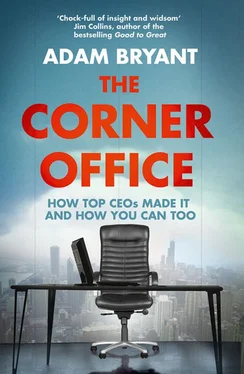“You need to jell with them as a team, but each one responds individually. So it’s about seeing the world on their terms and then dealing with them on their terms, not yours. I think you’re born with some of this as well. I’m very sensitive to how people are thinking and feeling at any given moment. That’s really helpful in business, because you pick things up very fast.”
Part of team building is understanding the roles that different personalities play in a group. For example, Will Wright, the video-game developer behind best-sellers like Spore and The Sims, sees people either as potential “glue” or “solvent” in a team setting when he is considering hiring someone.
“There is the matter of how good is this person, times their teamwork factor,” Wright said. “You can have a great person who doesn’t really work well on the team, and they’re a net loss. You can have somebody who is not that great, but they are really very good glue, so that could be a net gain. A lot of team members I consider glue within the team in that they disseminate things effectively, they motivate and improve the morale of people around them. They basically bring the team tighter and tighter. Others are solvents, and it’s their kind of personal nature that they might be disagreeable. They rub people the wrong way. They’re always caught in conflicts. For the most part, that is at least as important as their competence in their roles.”
Team smarts is about having good peripheral vision for sensing how people react to one another, not just how they act. George S. Barrett, the CEO of Cardinal Health, described an example of how he assessed different managers when he moved into a new role.
“I was running a company that was acquired by a bigger firm,” he said. “I stayed with them after the acquisition, and then I got a call from the chairman and he said, ‘We’re having some issues with our flagship company. Would you be willing to come in and run it?’ I was thirty-four years old, and I said to myself, ‘Well, it’s already struggling. How badly could I mess it up?’ So I went there. Everyone on the management team was in their fifties, so the first day I was introduced to them, I thought they were going to collapse. You could sort of see them thinking, ‘That kid?’
“I realized I was going to have to win these guys over pretty quickly. I also knew that there were some folks in that group who were probably not going to come along for the ride. It was a turnaround, so I knew that I was going to have to move quickly to fix some things. I was very clear and direct about what I thought we were facing and what we needed to do about it, without blame. I had to create an environment in which people knew it was their job to tell me things that we needed to do because we were going to run out of time. I tend to be very direct. I expect people to be that way with me.
“I concluded fairly quickly that not many of them would be staying. There were some very capable people there, but I just think the employees had lost confidence in them. That’s very hard to recover, because so much of leadership is about trust and belief. People have to believe in you. And when they stop believing in you, you can say all the things in the world, but it’s very, very hard to mobilize an organization when they’ve lost that belief.”
Barrett said that watching the managers, and watching the or ganization respond to them, helped him figure out who was going to remain on the team.
“I’ll give you an example,” he said. “We’re sitting with a large group of folks, about forty to fifty managers, and people are standing up to raise certain issues. And I watched this one executive. People were watching and riveted to him, really listening and engaged. And then this other executive spoke, and I watched him address the group, and I watched everyone’s eyes. And their eyes went back down to their tables. They couldn’t even meet eyes with him. It was a clear signal that said, ‘You’ve lost us.’ So sometimes you don’t know what the messages are that you’re going to get, but you have to look for them. They come from your peripheral vision. And that was one of those cases where I just knew it the second it happened.”
How do CEOs build a sense of teamwork, and not just team spirit? Mark Pincus of Zynga used an unusual strategy at one company to encourage each employee to understand his or her individual role better, and to take responsibility for it. He decided to take a more dramatic step after he grew frustrated that too many of his employees were coming to him for answers.
“I’d turn people into CEOs,” he said. “One thing I did at my second company was to put white sticky sheets on the wall, and I put everyone’s name on one of the sheets, and I said, ‘By the end of the week, everybody needs to write what you’re CEO of, and it needs to be something really meaningful.’ And that way, everyone knows who’s CEO of what and they know whom to ask instead of me. And it was really effective. People liked it. And there was nowhere to hide.
“We had this really motivated, smart receptionist. She was young. We kept outgrowing our phone systems, and she kept coming back and saying, ‘Mark, we’ve got to buy a whole new phone system.’ And I said, ‘I don’t want to hear about it. Just buy it. Go figure it out.’ She spent a week or two meeting every vendor and figuring it out. She was so motivated by that. I think that was a big lesson for me because what I realized was that if you give people really big jobs to the point that they’re scared, they have way more fun and they improve their game much faster. She ended up running our whole office.”
Nell Minow of The Corporate Library said her best lesson for building a sense of teamwork is to organize a group around a simple word: we.
“The first time I ever really thought of myself as a leader was when I had a series of experiences in college, over a period of about eighteen months, working on four different group projects,” Minow said. “What I learned from that is if you can get everyone to agree what the goal is, and to identify themselves with the successful achievement of that goal, then you’re pretty much there. One thing that helped move my thinking forward was that I noticed in my first job that there was something very definitional in who was included in somebody’s ‘we’ and who was included in somebody’s ‘them.’ I found generally that the more expansive the assumptions were within somebody’s idea of who ‘we’ is – the larger the group you include in that ‘we’—the better off everybody was. I started to really do my best to make sure that my notion of ‘we’ was very expansive and to promote that idea among other people.”
Another key strategy for building a sense of teamwork is learning to share credit.
“I was a mechanic in the Navy,” said Gordon Bethune, the former CEO of Continental Airlines. “And mechanics in the Navy are like mechanics in airlines. You may have more stripes than I do, but you don’t know how to fix the airplane. You want me to fix it? You know how much faster I could fix the airplane when I wanted to, than when I didn’t want to? So I’ve always felt that if you treat me with respect, I’ll do more for you. As I went up the ladder in the Navy, I never forgot what it’s like to be down the ladder, and that being good at your job is predicated pretty much on how the people working for you feel. Here’s my theory: Let’s say we’re all mid-level managers, and one VP slot is going to open up. I’ve got ten guys working for me, and for the last five years, every time I got any recognition, I said, ‘Bring them on the stage with me.’ Who do you think is going to get the job? I’m going to get the job.”
Teamwork can be built by being explicit about the roles people play, and insisting on rules and routines. Jilly Stephens, the executive director of City Harvest, a nonprofit organization that helps feed the hungry in New York, learned this lesson when she had a leadership position in her twenties at Orbis International, where she had responsibility for coordinating the medical teams aboard a “hospital with wings”—a plane that flew around to developing countries to perform eye surgeries.
Читать дальше












